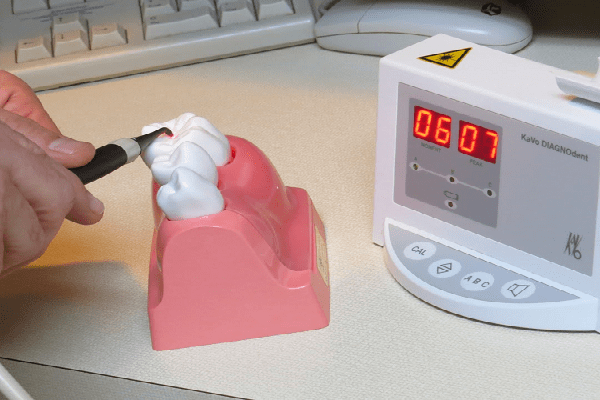Medical procedures >>>> Electrodiagnostics in dental treatment
Electroodontodiagnostics in dental treatment.

Not very popular due to the patients' ignorance, but a very effective method for diagnosing the condition of the tooth pulp using electrical stimulation is electroodontodiagnostics (EDI).
This method makes it possible to understand how the tooth pulp is involved in hidden pathological processes in the tooth, whether it is worth opening the pulp chamber and removing the nerve in the treatment of many diseases, or is it still possible to preserve the innervation and blood supply of the tooth, and therefore give it the opportunity to receive nutrients in the future to maintain a full-fledged structure of dental tissues.
Most often, the doctor receives information about the condition of the problem tooth from a physical examination of its sensitivity - tapping on the tooth (percussion), complaints of the patient himself and X-ray, laser or transillumination examination (LED diagnostics) of the pulp state. But the reaction of the tooth to mechanical stimuli and visualization of inflammatory processes in the pulp area may not give a complete picture of the state of the pulp, and leave the doctor no choice but to decide on its removal.
Electroodontodiagnostics in dental treatment solves the problem of fine diagnostics of the state of the pulp when it is in various stages of inflammatory processes in the surrounding tissues of the tooth, which is very effective in terms of making a diagnosis and deciding whether to depulp a tooth or leave it "alive".
Electrodontodiagnostics is carried out using an electrodontometer, an apparatus that generates weak electrical impulses and evaluates the electrical conductivity of the nerve endings of the pulp. The diagnostic procedure itself is called "electrodontometry".
It was noticed that at different stages of the involvement of the pulp (its parts) in inflammatory processes, the electrical conductivity of the nerve bundle of the pulp changes, which is reflected in the varying degrees of the pulp's reaction to electrical stimulation (electric shock).
For the patient, this procedure is reflected in weak jolts in the area of the tooth when the tooth touches the electrode of the apparatus and weak pain impulses (or tingling sensations), but for a dentist this is completely different information - these are accurate indicators of various pulp reactions in all areas of its length. So, the more the pulp is involved in the inflammatory process, the greater the intensity of the electric current it needs to form a pain symptom. That is, the electrical sensitivity of the pulp directly depends on its damage and decreases in proportion to the damage to the pulp (pain symptoms weaken as a reaction to electrical stimulation).
The electroodontodiagnostics procedure is safe for the patient in terms of the strength of the electric shock, but it has a number of contraindications. Electroodontodiagnostics is categorically contraindicated for people:
- diagnosed with arrhythmia,
- with an unstable state of mind,
- at the time of taking by the patient analgesic, narcotic drugs, tranquilizers, alcohol-containing drugs,
- with implanted electrostimulators and other non-removable metal structures - orthopedic or physiological devices with metal parts,
- with fixed metal prostheses (crowns, bridges, intra-root metal pins and stump inlays), including combined ones (for example, metal-ceramic, metal-plastic prostheses, metal-containing fillings and dental inlays, pin teeth, implants).
During the procedure, the patient will be asked to remove all metal jewelry and accessories, electronic gadgets and devices from the body.
In what cases is electroodontodiagnostics carried out:
- With closed injuries of the tooth (without visible external destruction of the tooth, for example, upon impact);
- With various degrees of carious damage to the tooth;
- In chronic forms of pulpitis;
- With periodontitis;
- With inflammatory diseases in the bone tissue of the jaw;
- With various kinds of inflammation in the dentition as a whole (check the sensitivity of each tooth);
- With various injuries of the branches of the trigeminal nerve passing through the dentoalveolar system.

Read

Read



























